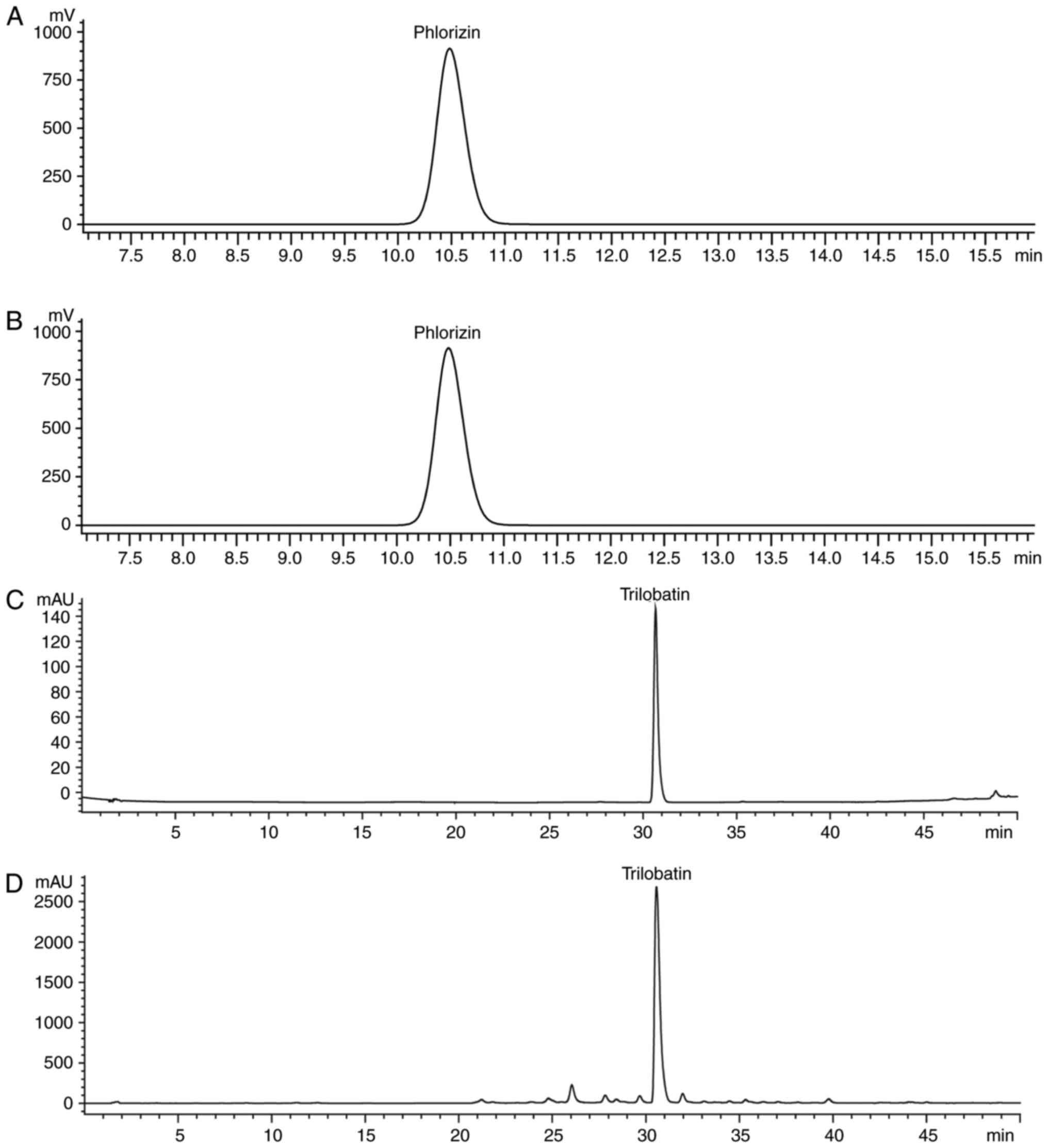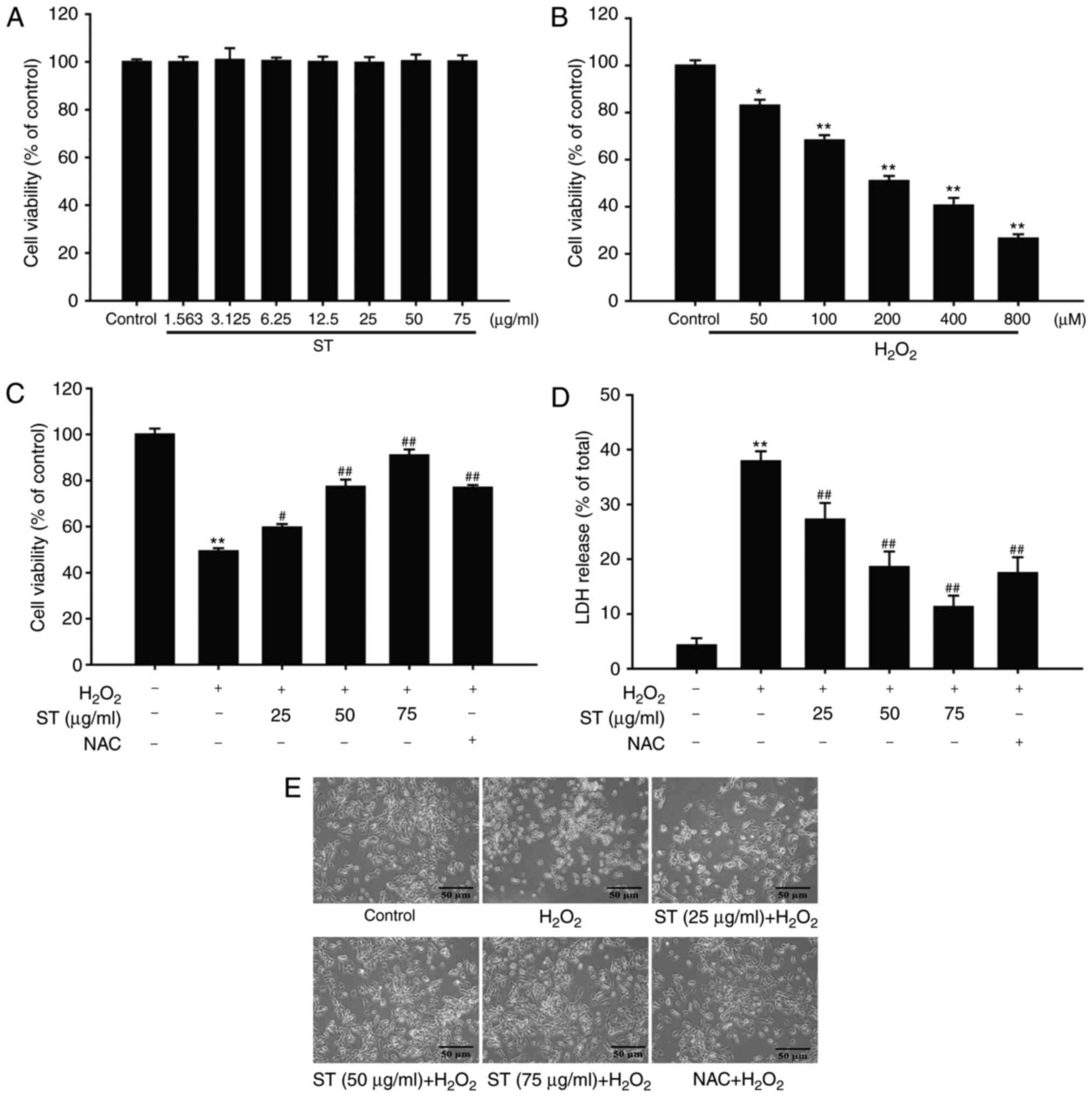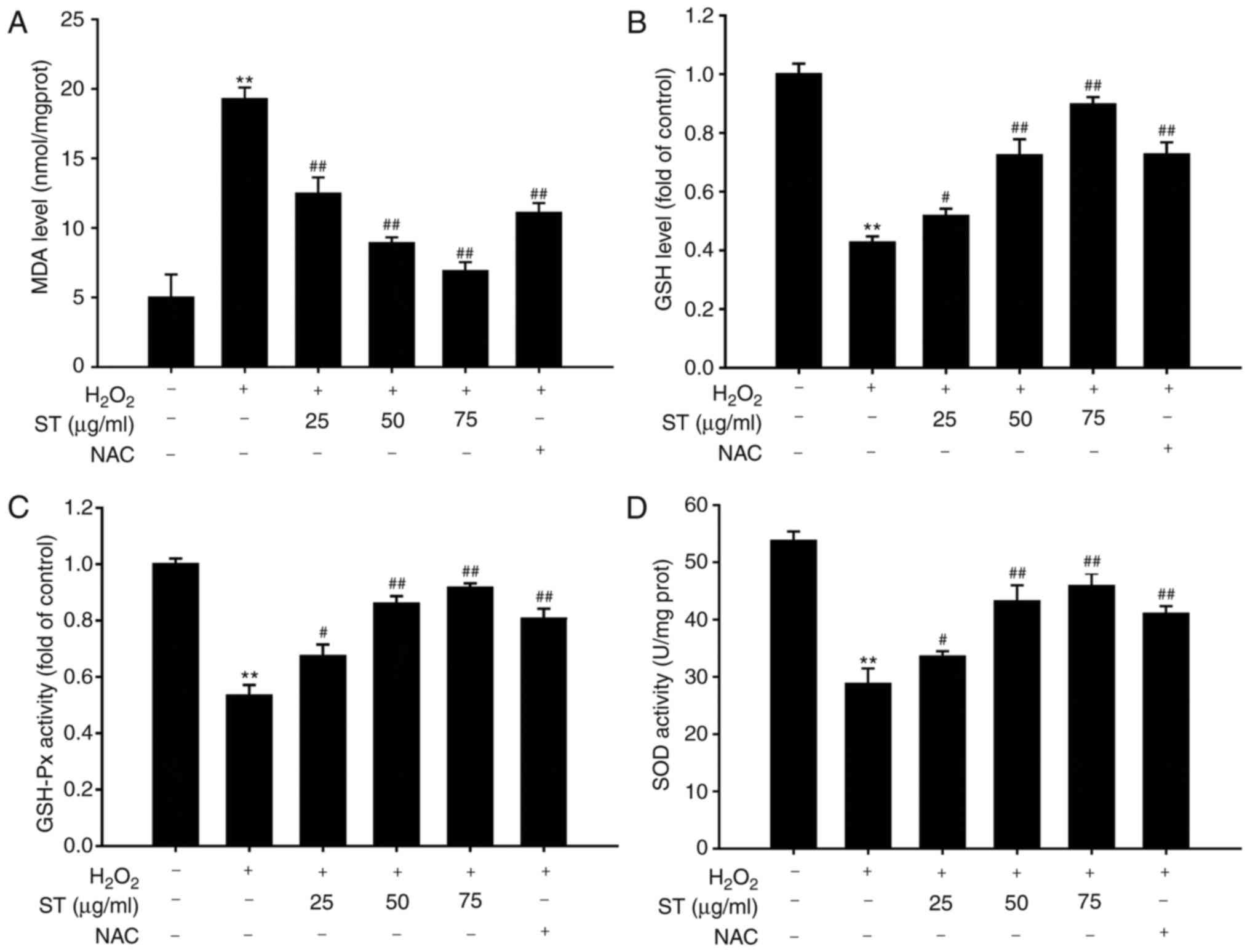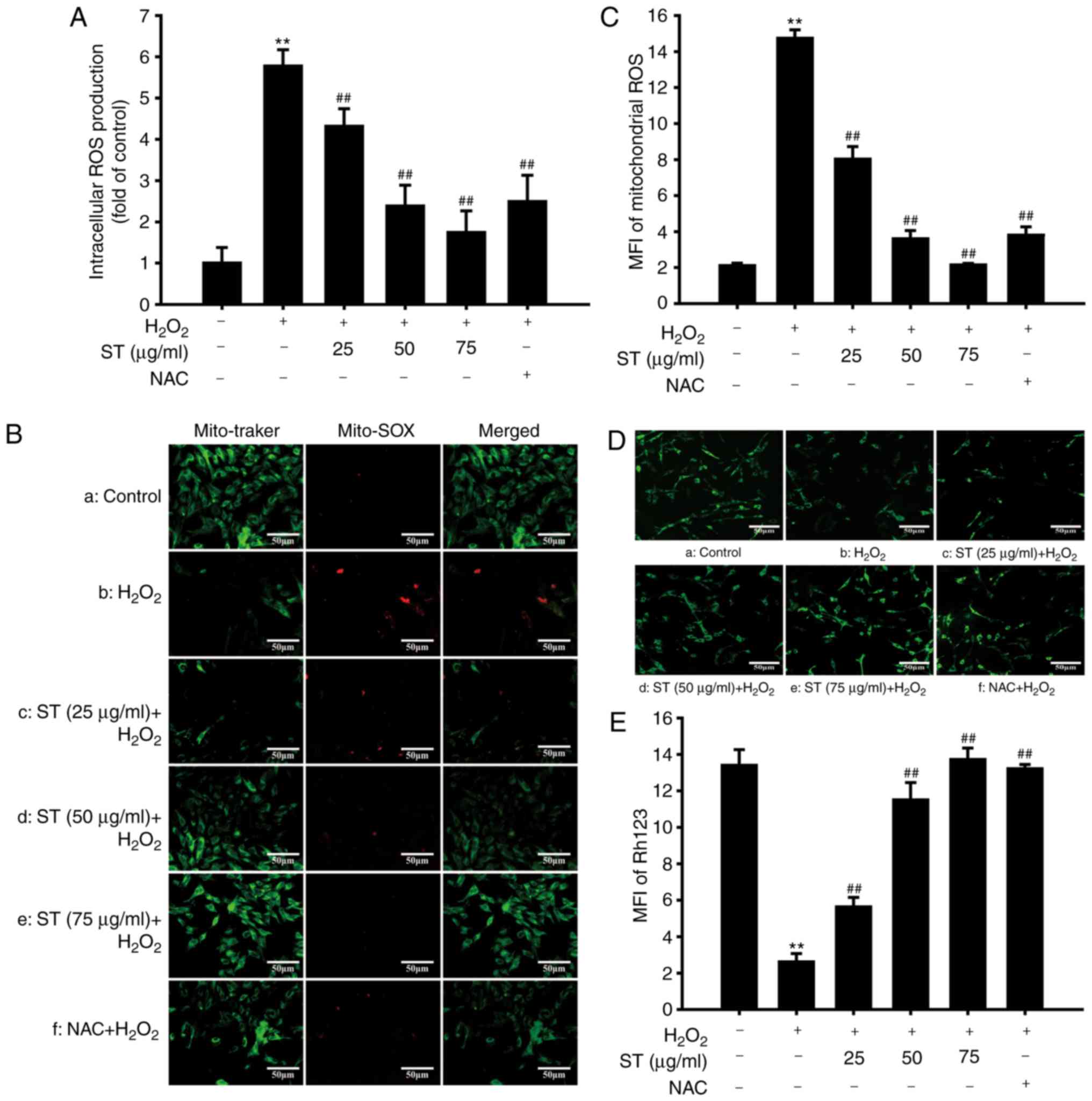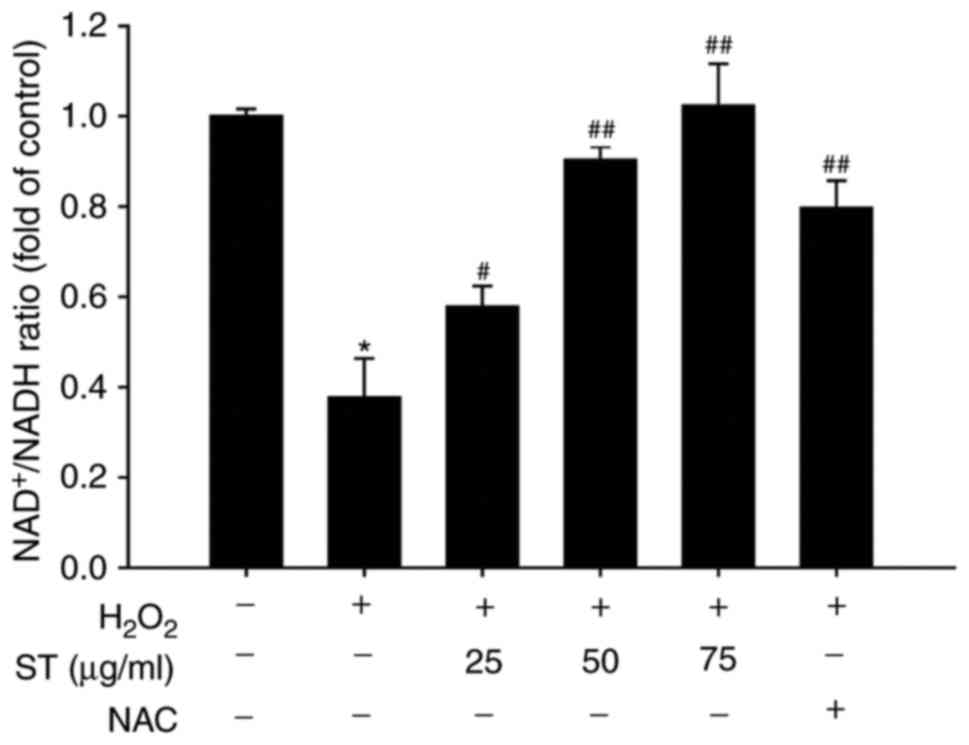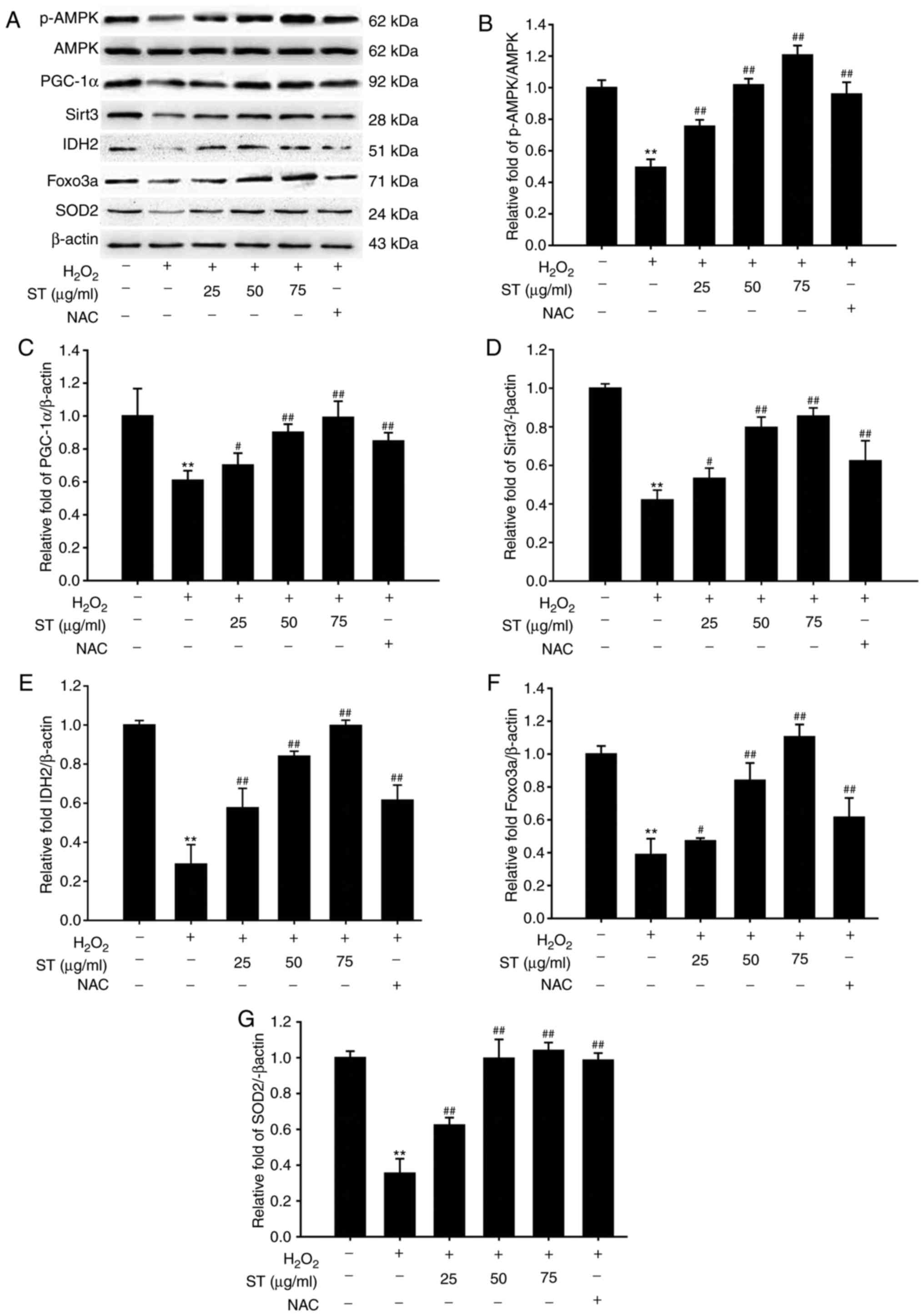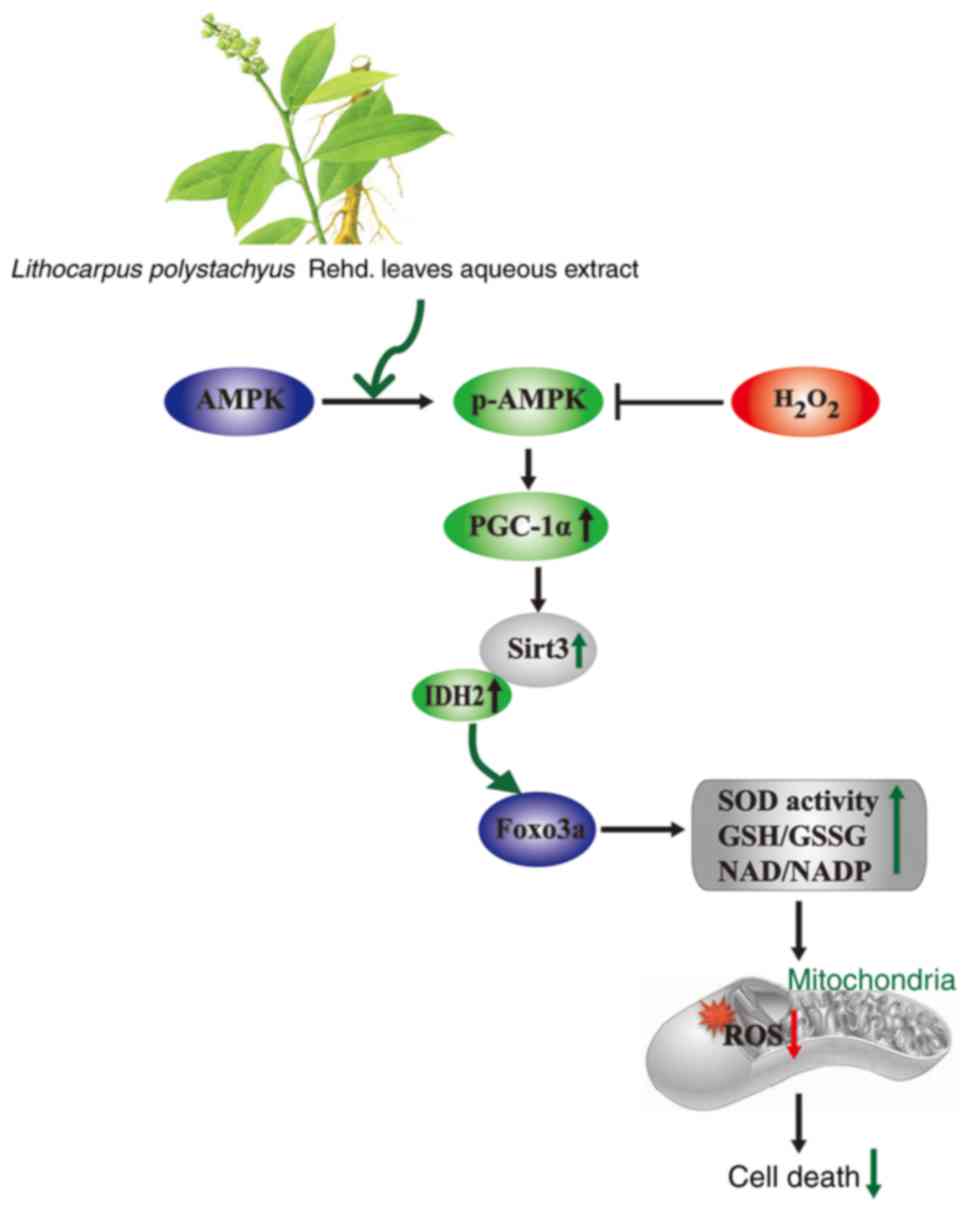Lithocarpus polystachyus Rehd. leaves aqueous extract protects against hydrogen peroxide‑induced SH-SY5Y cells injury through activation of Sirt3 signaling pathway
- Authors:
- Published online on: October 5, 2018 https://doi.org/10.3892/ijmm.2018.3916
- Pages: 3485-3494
Abstract
Introduction
Oxidative stress is one of the main causes of neuronal injury in neurodegenerative disorders, involving different signaling pathways (1). Evidence declares that reactive oxygen species (ROS) or hydrogen peroxide (H2O2), a main precursor of ROS, induces neuronal cell death contributing to the pathogenesis in neurodegenerative disorders such as Alzheimer's and Parkinson's diseases and stroke (2). Neuronal cells respond to H2O2 with cytotoxicity and neurodegeneration, whereas antioxidants may abolish these effects (3). Notably, mitochondria is the major source of ROS and mitochondrial dysfunction has been recognized as a critical contributor to the neurodegenera-tive disorders (4). Furthermore, the antioxidant defense system serves vital role in regulating oxidative stress, and Chinese medicinal herbs provide rich resources for developing natural antioxidants (5). Therefore, it is important to elucidate antioxidants from natural products and herbal medicine for treating neurodegenerative disorders.
Lithocarpus polystachyus Rehd. is distributed as a wild plant in the mountain area in Southern China, especially in Shiqian and Fenggang cities of the Guizhou Province with plentiful natural resources (6). It is also called ‘Sweet Tea’ (ST) and its leaves are used as a medicinal tea and a folk herbal medicine to prevent or cure multiple diseases for many years and exhibited no adverse drug reactions or toxic effects (7). Accumulating evidence demonstrates that ST has extensive pharmacological activities, including anti-hypertensive, anti-hypoglycemic, anti-diabetic and anti-obesity pharmacological effects (7-9). However, little is known about whether ST possesses protective effects on the oxidative stress-induced neuronal cell injury.
AMP-activated protein kinase (AMPK) is known as a vital intracellular serine/threonine protein kinase that regulates celluar energy metabolism and responses to metabolic stress (10). Additionally, AMPK-activated peroxisome proliferator-activated receptor coactivator-1α (PGC-1α) exerts crucial effect in the regulation of mitochondrial biogenesis and oxidative stress (11). Sirtuins belong to class III histone deacetylases family and their enzymatic activities are dependent on nicotinamide adenine dinucleotide, and seven mammalian homologues of sirtuins (Sirt1-7) have been identified (12). Among those sirtuins, Sirt3 has been demonstrated to control mitochondrial oxidative signaling, and serves as the downstream target of AMPK-PGC-1α signaling pathway (13,14). Additionally, a previous study reported that Sirt3 activation prevents neuronal mitochondrial oxidative stress and damage in neurodegenerative disorders (15). However, whether ST regulates neuronal Sirt3 and its corresponding upstream and downstream regulatory signaling pathways remain unclear.
Therefore, the present study was designed to determine the protective effect of ST on SH-SY5Y cell injury induced by H2O2, and to further elucidate its underlying mechanisms.
Materials and methods
Materials
Dulbecco's modified Eagle's medium: Nutrient Mixture F-12 (DMEM/F-12) (cat. no. 11320082), fetal bovine serum (FBS; cat. no. 1618862) and a penicillin/streptomycin mixture (cat. no. 15070-063) were obtained from Gibco; Thermo Fisher Scientific, Inc. (Waltham, MA, USA). 3-(4,5-dimethyl thiazol-2-yl)-2,5-diphenyl tetrazolium bromide (MTT; cat. no. M2128), 2′,7′-dichlorofluorescin diacetate (DCFH-DA; cat. no. D6883), and rhodamine 123 (R8004) were obtained from Sigma-Aldrich; Merck KGaA (Darmstadt, Germany). MitoSOX Red Mitochondrial Superoxide Indicator (M36008) and Mito Tracker green probe (M7514) were obtained from Invitrogen; Thermo Fisher Scientific, Inc. The lactate dehydrogenase (LDH; cat. no. A020-2), malondialdehyde (MDA; cat. no. A003-1), superoxide dismutase (SOD; cat. no. A001-3), reduced glutathione (GSH; cat. no. A006-2) and glutathione peroxidase (GSH-Px; cat. no. A005) assay kits were purchased by Nanjing Jiancheng Bioengineering Institute (Nanjing, China). Anti-adenosine monophosphate-activated protein kinase (AMP; cat. no. ab131512), anti-p-AMPK (cat. no. ab23875), anti-peroxisome proliferator-activated receptor coactivator-1α (PGC-1α; cat. no. ab54481), anti-Sirt3 (cat. no. ab217319), anti-isocitrate dehydrogenase (IDH2; cat. no. ab84726), anti-forkhead boxO3a (Foxo3a; cat. no. ab12162) and anti-SOD2 (cat. no. ab13533) antibodies were obtained from purchased from Abcam (Cambridge, UK). All other chemicals were of analytical grade.
Preparation of ST aqueous extracts
Fresh leaves of ST were obtained from Fenggang City in Guizhou Province in summer and identified by Professor Jianwen Yang (School of Pharmacy, Zunyi Medical University, Zunyi, China). A voucher specimen was deposited at the herbarium of School of Pharmacy, Zunyi Medical University (voucher number, 20151016ST). From 1 kg dried ST, 100 g of dried aqueous extract was obtained (yield 10%) and filtered. Subsequently, the filter liquor were condensed by rotary vacuum evaporation and lyophilized. The final powder was dissolved in double-distilled water, sterilized by passing through 0.22 µm filters, and attenuated in DMEM/F-12 culture solution prior to employ at a final concentration of 25, 50 or 75 µg raw herb/ml. ST was standardized by the content of phlorizin and trilobatin, which are the active components of ST (16). Phlorizin and trilobatin (Chengdu Push Bio-Technology Co., Ltd., Chengdu, China) were determined by reverse-phase high-performance liquid chromatography (HPLC; Agilent 1200 series; Agilent Technologies, Inc., Santa Clara, CA, USA) with a UV detector, auto-sampler, column oven, and multi-channel pump. Subsequently, the separation was executed by a Phenomenex Luna end-capped C18 column (5 mm, 4.6x250 mm; Phenomenex, CA, USA) at 25°C. The detector wavelength was set at 285 nm. The separated conditions of phlorizin were as follows: Acetonitrile: Water (30:70, v/v) as mobile phase using a linear gradient at a flow rate of 1.0 ml/min. The ST contained 1.19% phlorizin (Fig. 1A and B). The separated conditions of trilobatin were as follows: Acetic acid water: Methanol (40:60, v/v) as mobile phase using a linear gradient at a flow rate of 1.0 ml/min. The ST contained 18.54% trilobatin (Fig. 1C and D).
Cell culture
The human neuroblastoma SH-SY5Y cells were purchased from American Type Culture Collection (Manassas, VA, USA) and maintained in DMEM/F-12 supplemented with 10% FBS and 0.1% penicillin/streptomycin at 37°C in a humidified incubator containing 5% CO2 and 95% air.
MTT assay
Effect of ST on SH-SY5Y cell viability were determined using an MTT assay. In brief, SH-SY5Y cells were cultured in 96-well plates, at a density of 2x104 cells per well for 24 h at 37°C. Subsequently, the cells were pre-treated with various concentrations (25, 50 and 75 µg/ml) of ST aqueous extracts or NAC for 1 h and co-treatment with 200 µM H2O2 for the further 24 h at 37°C. Following the treatment, MTT solution was added to each well and the cells were cultured for 4 h at 37°C. The dark-blue formazan crystals were dissolved in DMSO, and the absorbance values were detected at 490 nm wavelength by microplate reader. In addition, according to our primary study, 20 µM NAC was chosen to be a positive control for antioxidant capacity that suppresses cell death for comparing with the possible protective effect of ST (17).
LDH leakage assay
The SH-SY5Y cells (2x104 cells per well) were pre-treated with or without ST as described above and the supernatant was analyzed by a LDH detection kit, according to the manufacturer's protocol. The leakage of LDH was determined at 490 nm wavelength using a microplate reader. At the same time, cellular morphologic changes were observed from five random fields using a phase contrast microscope (Olympus IX73; Olympus, Tokyo, Japan; magnification, x200).
Evaluation of MDA and GSH content, GPx and SOD activities
In brief, SH-SY5Y cells were treated as described above. MDA and GSH content, SOD and GSH-Px activities were detected by MDA, GSH, GSH-Px and SOD kits, respectively.
Measurement of intracellular and mitochondrial ROS accumulation
Intracellular ROS production was measured using DCFH-DA dye. Following SH-SY5Y cells were treated for 24 h as described above, 20 µM DCFH-DA dye treated cells for 30 min at 37°C in the dark. Subsequently, cells were washed with PBS, and intracellular ROS generation was measured using a fluorescence reader at excitation/emission wavelengths of 485/530 nm (Varioskan Flash Multimode Reader; Thermo Fisher Scientific, Inc.). Additionally, mitochondrial ROS was determined using MitoSOX Red, a fluorescent indicator for mitochondrial superoxide (18). In brief, SH-SY5Y cells were treated as described above and washed with balanced salt solution (Gibco). MitoSOX Red dye was used at a concentration of 5 µM for 20 min in the dark at 37°C. Subsequently, cells were washed using PBS and labeled with Mito Tracker green probe (200 nM) and stained for 20 min. Finally, cells were washed with PBS and fluorescence was observed over the whole field of vision using fluorescence microscopy (Olympus IX73; Olympus Corporation, Tokyo, Japan; magnification, x200) with excitation/emission (510/580 nm) filters. The mean fluorescence intensity (MFI) of MitoSOX Red from five random fields was calculated using ImageJ 1.47i software, and the MFI was applied as an index of the levels of mitochondrial ROS.
Measurement of mitochondrial membrane potential (MMP)
Measurement of MMP was detected using rhodamine 123 dye, a reliable indicator of MMP, as reported in previous studies (19,20). Briefly, SH-SY5Y cells were treated as described above. Subsequently, cells were stained using rhodamine with 2 µg/ml 123 dye for 20 min at 37°C in the dark, and cells were washed with PBS. Subsequently, fluorescence was observed over the whole field of vision using fluorescence microscopy (Olympus IX73; Olympus Corporation; magnification, x200) with excitation/emission (485/595 nm) filters. The MFI of Rh123 from five random fields was calculated using ImageJ 1.47i software, and the MFI was applied as an index of the levels of MMP.
NAD+/NADH measurement
The SH-SY5Y cells were treated as described above. By the end of treatment, NAD+/NADH ratio were measured using a NAD/NADH Quantification kit (cat. no. ab65348; Abcam) according to the manufacture's protocol, and absorbance was measured at 450 nm using the Varioskan Flash Multimode Reader.
Western blot analysis
Following pre-treatment with or without various concentrations (25, 50 and 75 µg/ml) of ST on SH-SY5Y cells for 1 h at 37°C prior to co-culture with 200 µM H2O2. Following 24 h incubation, cells were lysed in the lysis buffer (cat. no. 9803; Cell Signaling Technology), and protein concentrations were quantified using the BCA protein assay kit (cat. no. 7780; Cell Signaling Technology, Inc.). Subsequently, samples containing 20 µg proteins were subjected to 10% SDS-polyacrylamide gel, and transferred to a PVDF membrane (cat. no. 1620177; Bio-Rad Laboratories). Following blocking with 5% non-fat milk for 1 h at room temperature, the membrane was incubated overnight at 4°C with the appropriate primary antibodies: anti-p-AMPK (1:1,000), anti-AMPK (1:1,000), anti-PGC-1α (1:1,000), anti-Sirt3 (1:1,000), anti-IDH2 (1:1,000), anti-Foxo3a (1:1,000), anti-SOD2 (1:1,000). Subsequently, the membranes were washed with TBS with Tween-20, and incubated with appropriate HRP-conjugated goat anti-rabbit antibody (cat. no. A0208, Beyotime) and HRP-conjugated goat anti-rat antibody (cat. no. ab97057; Abcam) for 1 h at room temperature under shaking. The bonds of protein were developed with the ECL Western blot reagent (cat. no. P0018, Beyotime), and the blots was visualized using Davinch-Chemi™ imaging system and band optical intensity was quantified using Quantity One 1-D analysis software v4.52 (BioRad Laboratories, Inc., Hercules, CA, USA).
Statistical analysis
All data were confirmed by at least three independent experiments and were expressed as the mean ± standard deviation. Statistical analyses were performed using SPSS 17.0 software (SPSS, Inc., Chicago, IL, USA), and individual differences were determined using one-way analysis of variance, followed by the Fisher's least significant difference. P<0.05 was considered to indicate a statistically significant difference.
Results
ST protects SH-SY5Y cells against H2O2-induced cell injury
SH-SY5Y cells were treated with various concentrations of ST (3.125, 6.25, 12.5, 25, 50, and 75 µg/ml) for 24 h, and cell viability was subsequently detected using the MTT assay. Treatment with these concentrations of ST alone did not affect cell viability and caused no cell toxicity [F(7,16)=0.027, P=1.000; Fig. 2A]. Subsequently, the effect of H2O2 (50-800 µM) on SH-SY5Y cells was evaluated. The results indicated that H2O2 reduced cell viability in a concentration-dependent manner, and 200 µM H2O2 incubation with SH-SY5Y cells for 24 h was confirmed to be an appropriate condition to taken as an oxidative stress-induced injury in SH-SY5Y cellular model in vitro with approximately 50% cell viability inhibition rate [F (5,12)=200.045, P<0.001; Fig. 2B]. To investigate the protective effect of ST against H2O2-induced SH-SY5Y cell injury, SH-SY5Y cells were pre-treated with ST at different concentrations (25, 50, and 75 µg/ml) for 1 h, the co-treatment with 200 µM H2O2 for another 24 h. The results demonstrated that cell viability increased to 59.67, 77.33, 91.01 or 76.93% when cells were pre-treated with ST (25, 50, and 75 µg/ml) or NAC, respectively [F(5,12)=149.1724, P<0.001; Fig. 2C]. In parallel, 200 µM H2O2 significantly increased LDH release to 37.88%. However, pre-treatment with ST or NAC, reduced the amount of LDH release to 27.23, 18.55, 11.29 or 17.53% respectively [F(5,12)=75.218, P<0.001; Fig. 2D]. At the meantime, this protective effect of ST was also evidenced by morphologic observations of SH-SY5Y cells. In the case of H2O2-treated cells, most cells demonstrated shrinkage and floatation. However, the SH-SY5Y cells were pre-treated with ST or NAC displayed slightly morphological changes (Fig. 2E). These findings indicated that the protective effects of ST were equal or higher than those exerted by an equivalent concentration of positive control agent.
ST attenuated H2O2-induced accumulation of MDA, enhanced GSH content, GSH-Px, and SOD activities
The results indicated that H2O2 caused a remarkable increase in MDA content and decrease in GSH content, SOD and GSH-Px activities. However, pre-treatment with ST (25, 50, and 75 µg/ml) significantly reduced the increase in MDA content induced by H2O2 [F(5,12)=77.225, P<0.001; Fig. 3A], while it significantly reversed the decrease in GSH content, GSH-Px and SOD activities induced by H2O2 treatment in a concentration-dependent manner [F(5,12)=131.886, P<0.001; F(5,12)=57.409, P<0.001; F(5,12)=97.466, P<0.001, respectively; Fig. 3B-D].
ST attenuated H2O2-induced accumulation of intracellular and mitochondrial ROS production, improved MMP
Effects of ST on intracellular, mitochondrial ROS production, and MMP were evaluated. The results demonstrated that following treatment with H2O2, the levels of intracellular ROS increased markedly within 24 h. Pre-treatment with ST (25, 50, and 75 µg/ml) suppressed H2O2-induced excessive ROS production [F(5,12)=154.603, P<0.001; Fig. 4A]. Furthermore, to determine the level of oxidative stress in mitochondria during H2O2 treatment, SH-SY5Y cells were stained with MitoSOX, a cationic probe that distributes to the mitochondrial matrix and specifically measures superoxide anion, and co-localizes with Mito Tracker Green (21). Compared with the control, H2O2 notably accelerated the accumulation of mitochondrial ROS which was decreased by ST pre-treatment [F(5,12)=382.644, P<0.001; Fig. 4B and C]. Furthermore, MMP indicates the function of mitochondria (22). H2O2 decreased rhodamine 123 fluorescence intensity, while this decrease in rhodamine 123 fluorescence was abrogated by pre-treatment with ST or NAC [F(5,12)=156.453, P<0.001; Fig. 4D and E]. These results demonstrated that ST effectively inhibited ROS levels and attenuated reduction in MMP induced by H2O2 in SH-SY5Y cells.
ST increased NAD+/NADH ratio, AMPK, PGC-1α, Sirt3, IDH2, Foxo3a, SOD2 in SH-SY5Y cells
The results demonstrated that H2O2 decreased the ratio of NAD+/NADH, while pre-treated with ST increased the ratio of NAD+/NADH in SH-SY5Y cells [F(5,12)=91.125, P<0.001; Fig. 5]. AMPK-PGC-1α signaling serves an important role in regulating mitochondrial function and oxidative stress and has been reported to serve as the downstream target of AMPK-PGC-1α signaling (23). Therefore, the effects of ST on the protein expressions of AMPK, PGC-1α, Sirt3, IDH2, Foxo3a, SOD2 in H2O2-induced SH-SY5Y cells evaluated, using western blot analysis. The results demonstrated that 200 µM H2O2 decreased the ratio of p-AMPK/AMPK and the expression of PGC-1α and Sirt3. However, ST pre-treatment prominently elevated the p-AMPK/AMPK ratio and the expression of PGC-1α and Sirt3 [F(5,12)=29.286, P<0.001; F(5,12)=9.640, P<0.001; F(5, 12)=14.183, P<0.001; Fig. 6A-D], indicating that the AMPK-PGC-1α-Sirt3 axis was crucial for the protective effects of ST on regulation of mitochondrial ROS homeostasis in SH-SY5Y cells. Considering that Sirt3 is an NAD+-dependent deacetylase, and IDH2, Foxo3a and SOD2 are major substrates of Sirt3. IDH2, Foxo3a and SOD2 expressions were also investigated. The results showed that ST pre-treatment notably increased IDH2, Foxo3a and SOD2 expression compared with H2O2 treatment [F(5,12)=11.078, P<0.001; F(5,12)=20.023, P<0.001; F(5,12)=15.505, P<0.001; Fig. 6A and E-G], suggesting that ST ameliorated H2O2 induced mitochondrial dysfunction and reduced oxidative stress were mediated by the activation of AMPK-PGC-1α-Sirt3 signaling.
Discussion
Excessive oxidative stress has been demonstrated to serve a crucial role in neurodegenerative diseases (24). H2O2 not only is the most steady ROS but also serves as extracellular and intercellular messenger (25,26). Therefore, in the present study, H2O2 was used as a toxic agent to simulate oxidative stress-induced neuronal injury in vitro, thereby leading to mitochondrial injury as described in our previous study (27). The results demonstrated that H2O2-induced neuronal cell injury as evidenced by decreasing cell viability and increasing cell death, combined with the repression of MMP and generation of excessive ROS in the mitochondria, which were significantly reversed by pre-treatment with ST. The present findings, for the first time to the best of our knowledge, clarified that ST exerted the protective effects on oxidative stress-induced neuronal cells injury.
Furthermore, emerging evidence demonstrates that mitochondria are the major resource of ROS, and the mitochondrial ROS free radical scavenging systems, including SOD2 and the glutathione and thioredoxin systems, serves an key role in regulating mitochondrial ROS (28). In the present study, H2O2 decreased the enzymatic activities of SOD2, GSH-Px and IDH2, while these effects were reversed by pre-treatment of ST. Furthermore, MitoSOX Red, a cationic probe that distributes to the mitochondrial matrix and specifically detects superoxide, was used to determine the mitochondrial ROS as described in our previous study (27). The results suggested that ST scavenged excessive mitochondrial ROS via elevating ROS free radical scavenging systems, thereby promoted GSH levels and maintained NAD+/NADH ratio, which acts as an important role in donating electrons when NADH converts into NAD+, and eliminating excessive ROS (29). In addition, sirtuins are NAD+-dependent enzymes, which include seven homologues (Sirt1-7), and they deacetylate multiple substrates to execute numerous physiological and pathophysiological functions (30). Sirt3 is known as an important member of the sirtuin family, and it not only localizes in mitochondria but also suppresses the excessive ROS production due to deacetylating many mitochondrial proteins such as SOD2, IDH2, which improve the glutathione antioxidant defense system (31). Furthermore, the present findings indicated that H2O2 decreased Sirt3, Foxo3a and SOD2 expressions, which was consistent with the theory that oxidative stress downregulates Foxo3a and SOD2, which are the two main substrates of Sirt3 (32,33). However, these effects were abolished by pre-treatment with ST, suggesting that ST activated Sirt3, thereby regulating Foxo3a directly and elevating SOD2 activity, which is mainly regulated by the mitochondrial sirtuin to eliminate excessive ROS (34).
Additionally, growing evidence demonstrated that Sirt3 serves as a downstream target of PGC-1α, which has been demonstrated as the pivotal downstream target of AMPK, thereby activating Foxo3a to reduce mitochondrial ROS production (35,36). It is also postulated that decreased AMPK-PGC-1α signaling pathway may lead to downregulation of Sirt3 expression (37). The results in the current study demonstrated that H2O2 decreased p-AMPK and PGC-1α expression, which was consistent with the theory that oxidative stress inhibits AMPK, and downregulates PGC-1α and Sirt3 expression. However, pre-treatment with ST reversed these effects, suggesting that ST preserved mitochondrial function and attenuated excessive ROS through activating the phosphorylation of AMPK, thereby upregulating PGC-1α and Sirt3. Therefore, it can be concluded that the AMPK-PGC-1α-Sirt3 signaling pathway serves a crucial role in regulating mitochondrial ROS homeostasis by ST pre-treatment in oxidative stress-induced neuronal cell injury.
To conclude, the present findings indicated that ST protects against oxidative stress-induced neuronal cell injury in vitro through attenuating mitochondrial ROS, at least partly, through activating Sirt3 signaling pathway (Fig. 7). These results provide valuable insights for the role of ST, which may lead to its development as a natural antioxidant to protect neurode-generative diseases, but this needs to be further investigated.
Acknowledgements
Not applicable.
Funding
The present study was supported by Natural Science Foundation of China (grant no. 81560666), Program for excellent young talents of Zunyi Medical Uiverstity (grant no. 15zy-002). Science and Technology Innovation Talent Team of Guizhou Province (grant no. 20154023). The ‘hundred’ level of high-level innovative talents in Guizhou Province (grant no. QKHRCPT 20165684), and Program for Changjiang Scholars and Innovative Research Team in University, China (grant no. IRT17R113).
Availability of data and materials
The analyzed data sets generated during the study are available from the corresponding author on reasonable request.
Authors' contributions
JG performed MTT assay, LDH leakage assay, MDA, GSH content, GPx, SOD activities analysis, ROS production, MMP analysis and was major contributor in writing the manuscript. ST aqueous extracts experiment was conducted by YX. JZ performed the western blot analysis. JS and QG designed the experimental approaches. All authors read and approved the final manuscript.
Ethics approval and consent to participate
Not applicable.
Patient consent for publication
Not applicable.
Competing interests
The authors declare they have no competing interests.
Abbreviations:
|
ROS |
reactive oxygen species |
|
DCFH-DA |
2′,7′-dichlorofluorescin diacetate |
|
MDA |
malondialdehyde |
|
SOD |
superoxide dismutase |
|
GSH |
reduced glutathione |
|
GSH-Px |
glutathione peroxidase |
|
AMPK |
adenosine monophosphate-activated protein kinase |
|
PGC-1α |
peroxisome proliferator-activated receptor coactivator-1α |
|
Foxo3a |
forkhead box O3a |
References
|
Liu L, Zhang K, Sandoval H, Yamamoto S, Jaiswal M, Sanz E, Li Z and Hui J: Glial lipid droplets and ROS induced by mitochondrial defects promote neurodegeneration. Cell. 160:177–190. 2015. View Article : Google Scholar : PubMed/NCBI | |
|
Zhang JX, Wang R, Xi J, Shen L, Zhu AY, Qi Q, Wang QY, Zhang LJ, Wang FC, Lü HZ and Hu JG: Morroniside protects SK-N-SH human neuroblastoma cells against H2O2-induced damage. Int J Mol Med. 39:603–612. 2017. View Article : Google Scholar : PubMed/NCBI | |
|
Hanschmann EM, Godoy JR, Berndt C, Hudemann C and Lillig CH: Thioredoxins, glutaredoxins, and peroxire-doxins-molecular mechanisms and health significance: From cofactors to antioxidants to redox signaling. Antioxid Redox Signal. 19:1539–1605. 2013. View Article : Google Scholar : PubMed/NCBI | |
|
Tseng AH, Shieh SS and Wang DL: SIRT3 deacetylates FOXO3 to protect mitochondria against oxidative damage. Free Radic Biol Med. 63:222–234. 2013. View Article : Google Scholar : PubMed/NCBI | |
|
Wang Y, Wang Y, Li J, Hua L, Han B, Zhang Y, Yang X, Zeng Z, Bai H, Yin H and Lou J: Effects of caffeic acid on learning deficits in a model of Alzheimer's disease. Int J Mol Med. 38:869–875. 2016. View Article : Google Scholar : PubMed/NCBI | |
|
Wang J, Huang Y, Li K, Chen Y, Vanegas D, McLamore ES and Shen Y: Leaf extract from Lithocarpus polystachyus Rehd promote glycogen synthesis in T2DM mice. PLoS One. 11:e01665572016. View Article : Google Scholar | |
|
Hou SZ, Chen SX, Huang S, Jiang DX, Zhou CJ, Chen CQ, Liang YM and Lai XP: The hypoglycemic activity of Lithocarpus polystachyus Rehd leaves in the experimental hyperglycemic rats. J Ethnopharmacol. 138:142–149. 2011. View Article : Google Scholar : PubMed/NCBI | |
|
Hou SZ, Xu SJ, Jiang DX, Chen SX, Wang LL, Huang S and Lai XP: Effect of the flavonoid fraction of Lithocarpus polys-tachyus Rehd on spontaneously hypertensive and normotensive rats. J Ethnopharmacol. 143:441–447. 2012. View Article : Google Scholar : PubMed/NCBI | |
|
Zhou CJ, Huang S, Liu JQ, Qiu SQ, Xie FY, Song HP, Li YS, Hou SZ and Lai XP: Sweet tea leaves extract improves leptin resistance in diet-induced obese rats. J Ethnopharmacol. 145:386–392. 2013. View Article : Google Scholar | |
|
Gao XY, Wang SN, Yang XH, Lan WJ, Chen ZW, Chen JK, Xie JH, Han YF, Pi RB and Yang XB: Gartanin protects neurons against glutamate-induced cell death in HT22 cells: Independence of Nrf-2 but involvement of HO-1 and AMPK. Neurochem Res. 41:2267–2277. 2016. View Article : Google Scholar : PubMed/NCBI | |
|
Cheng L, Li B, Chen X, Su J, Wang H, Yu S and Zheng Q: CTRP9 induces mitochondrial biogenesis and protects high glucose-induced endothelial oxidative damage via AdipoR1-SIRT1-PGC-1α activation. Biochem Biophys Res Commun. 477:685–691. 2016. View Article : Google Scholar : PubMed/NCBI | |
|
Kincaid B and Bossy-Wetzel E: Forever young: SIRT3 a shield against mitochondrial meltdown, aging, and neurodegeneration. Front Aging Neurosci. 5:482013. View Article : Google Scholar : PubMed/NCBI | |
|
Guan Y, Cui ZJ, Sun B, Han LP, Li CJ and Chen LM: Celastrol attenuates oxidative stress in the skeletal muscle of diabetic rats by regulating the AMPK-PGC1α-SIRT3 signaling pathway. Int J Mol Med. 37:1229–1238. 2016. View Article : Google Scholar : PubMed/NCBI | |
|
Wang Q, Li L, Li CY, Pei Z, Zhou M and Li N: SIRT3 protects cells from hypoxia via PGC-1α- and MnSOD-dependent pathways. Neuroscience. 286:109–121. 2015. View Article : Google Scholar | |
|
Rangarajan P, Karthikeyan A, Lu J, Ling EA and Dheen ST: Sirtuin 3 regulates Foxo3a-mediated antioxidant pathway in microglia. Neuroscience. 311:398–414. 2015. View Article : Google Scholar : PubMed/NCBI | |
|
Dong H, Ning Z, Yu L, Li L, Lin L and Huang J: Preparative separation and identification of the flavonoid phlorhizin from the crude extract of Lithocarpus polystachyus Rehd. Molecules. 12:552–562. 2007. View Article : Google Scholar : PubMed/NCBI | |
|
Chen TY, Chi KH, Wang JS, Chien CL and Lin WW: Reactive oxygen species are involved in FasL-induced caspase-independent cell death and inflammatory responses. Free Radic Biol Med. 46:643–655. 2009. View Article : Google Scholar | |
|
Ishii T, Takanashi Y, Sugita K, Miyazawa M, Yanagihara R, Yasuda K, Onouchi H, Kawabe N, Nakata M, Yamamoto Y, et al: Endogenous reactive oxygen species cause astrocyte defects and neuronal dysfunctions in the hippocampus: A new model for aging brain. Aging Cell. 16:39–51. 2017. View Article : Google Scholar : | |
|
Gao JM, Li R, Zhang L, Jia LL, Ying XX, Dou DQ, Li JC and Li HB: Cuscuta chinensis seeds water extraction protecting murine osteoblastic MC3T3-E1 cells against tertiary butyl hydroperoxide induced injury. J Ethnopharmacol. 148:587–595. 2013. View Article : Google Scholar : PubMed/NCBI | |
|
Yang YY, Sun XT, Li ZX, Chen WY, Wang X, Liang ML, Shi H, Yang ZS and Zeng WT: Protective effect of angiotensin-(1-7) against hyperglycaemia-induced injury in H9c2 cardiomyoblast cells via the PI3KAkt signaling pathway. Int J Mol Med. 41:1283–1292. 2018. | |
|
Roelofs BA, Ge SX, Studlack PE and Polster BM: Low micromolar concentrations of the superoxide probe MitoSOX uncouple neural mitochondria and inhibit complex IV. Free Radic Biol Med. 86:250–258. 2015. View Article : Google Scholar : PubMed/NCBI | |
|
Lee Y, Heo G, Lee KM, Kim AH, Chung KW, Im E, Chung HY and Lee J: Neuroprotective effects of 2,4-dinitrophenol in an acute model of Parkinson's disease. Brain Res. 1663:184–193. 2017. View Article : Google Scholar : PubMed/NCBI | |
|
Hong YA, Lim JH, Kim MY, Kim Y, Park HS, Kim HW, Choi BS, Chang YS, Kim HW, Kim TY and Park CW: Extracellular superoxide dismutase attenuates renal oxidative stress through the activation of adenosine monophosphate-activated protein kinase in diabetic nephropathy. Antioxid Redox Signal. 28:1543–1561. 2018. View Article : Google Scholar | |
|
Gao C, Chang P, Yang L, Wang Y, Zhu S, Shan H, Zhang M and Tao L: Neuroprotective effects of hydrogen sulfide on sodium azide-induced oxidative stress in PC12 cells. Int J Mol Med. 41:242–250. 2018. | |
|
Di Domenico F, Barone E, Perluigi M and Butterfield DA: The triangle of death in Alzheimer's disease brain: The aberrant cross-talk among energy metabolism, mammalian target of rapamycin signaling, and protein homeostasis revealed by redox proteomics. Antioxid Redox Signal. 26:364–387. 2017. View Article : Google Scholar | |
|
Wang X, Dong W, Yuan B, Yang Y, Yang D, Lin X, Chen C and Zhang W: Vitamin E confers cytoprotective effects on cardiomyocytes under conditions of heat stress by increasing the expression of metallothionein. Int J Mol Med. 37:1429–1436. 2016. View Article : Google Scholar : PubMed/NCBI | |
|
Gao J, Deng Y, Yin C, Liu Y, Zhang W, Shi J and Gong Q: Icariside II, a novel phosphodiesterase 5 inhibitor, protects against H2O2-induced PC12 cells death by inhibiting mitochondria-mediated autophagy. J Cell Mol Med. 21:375–386. 2017. View Article : Google Scholar | |
|
Zhong J, Xu C, Gabbay-Benziv R, Lin X and Yang P: Superoxide dismutase 2 overexpression alleviates maternal diabetes-induced neural tube defects, restores mitochondrial function and suppresses cellular stress in diabetic embryopathy. Free Radic Biol Med. 96:234–244. 2016. View Article : Google Scholar : PubMed/NCBI | |
|
Rottenberg H and Hoek JB: The path from mitochondrial ROS to aging runs through the mitochondrial permeability transition pore. Aging Cell. 16:943–955. 2017. View Article : Google Scholar : PubMed/NCBI | |
|
Zhang JY, Deng YN, Zhang M, Su H and Qu QM: SIRT3 acts as a neuroprotective agent in rotenone-induced Parkinson cell model. Neurochem Res. 41:1761–1773. 2016. View Article : Google Scholar : PubMed/NCBI | |
|
Yin J, Han P, Tang Z, Liu Q and Shi J: Sirtuin 3 mediates neuro-protection of ketones against ischemic stroke. J Cereb Blood Flow Metab. 35:1783–1789. 2015. View Article : Google Scholar : PubMed/NCBI | |
|
Zhou X, Chen M, Zeng X, Yang J, Deng H, Yi L and Mi MT: Resveratrol regulates mitochondrial reactive oxygen species homeostasis through Sirt3 signaling pathway in human vascular endothelial cells. Cell Death Dis. 5:e15762014. View Article : Google Scholar : PubMed/NCBI | |
|
Guo Q, Li S, Xie Y, Zhang Q, Liu M, Xu Z, Sun H and Yang Y: The NAD+-dependent deacetylase, Bifidobacterium longum Sir2 in response to oxidative stress by deacetylating SigH (sigmaH) and FOXO3a in Bifidobacterium longum and HEK293T cell respectively. Free Radic Biol Med. 108:929–939. 2017. View Article : Google Scholar : PubMed/NCBI | |
|
Guo Y, Li Z, Shi C, Li J, Yao M and Chen X: Trichostatin A attenuates oxidative stress-mediated myocardial injury through the FoxO3a signaling pathway. Int J Mol Med. 40:999–1008. 2017. View Article : Google Scholar : PubMed/NCBI | |
|
Yu L, Gong B, Duan W, Fan C, Zhang J, Li Z, Xue X, Xu Y, Meng D, Li B, et al: Melatonin ameliorates myocardial ischemia/reperfusion injury in type 1 diabetic rats by preserving mitochondrial function: Role of AMPK-PGC-1α-SIRT3 signaling. Sci Rep. 7:413372017. View Article : Google Scholar | |
|
Dai SH, Chen T, Wang YH, Zhu J, Luo P, Rao W, Yang YF, Fei Z and Jiang XF: Sirt3 attenuates hydrogen peroxide-induced oxidative stress through the preservation of mitochondrial function in HT22 cells. Int J Mol Med. 34:1159–1168. 2014. View Article : Google Scholar : PubMed/NCBI | |
|
Karnewar S, Neeli PK, Panuganti D, Kotagiri S, Mallappa S, Jain N, Jerald MK and Kotamraju S: Metformin regulates mitochondrial biogenesis and senescence through AMPK mediated H3K79 methylation: Relevance in age-associated vascular dysfunction. Biochim Biophys Acta. 1864:1115–1128. 2018. View Article : Google Scholar |



